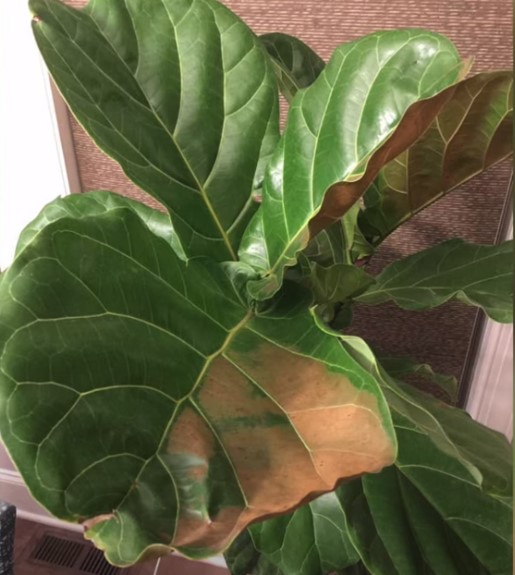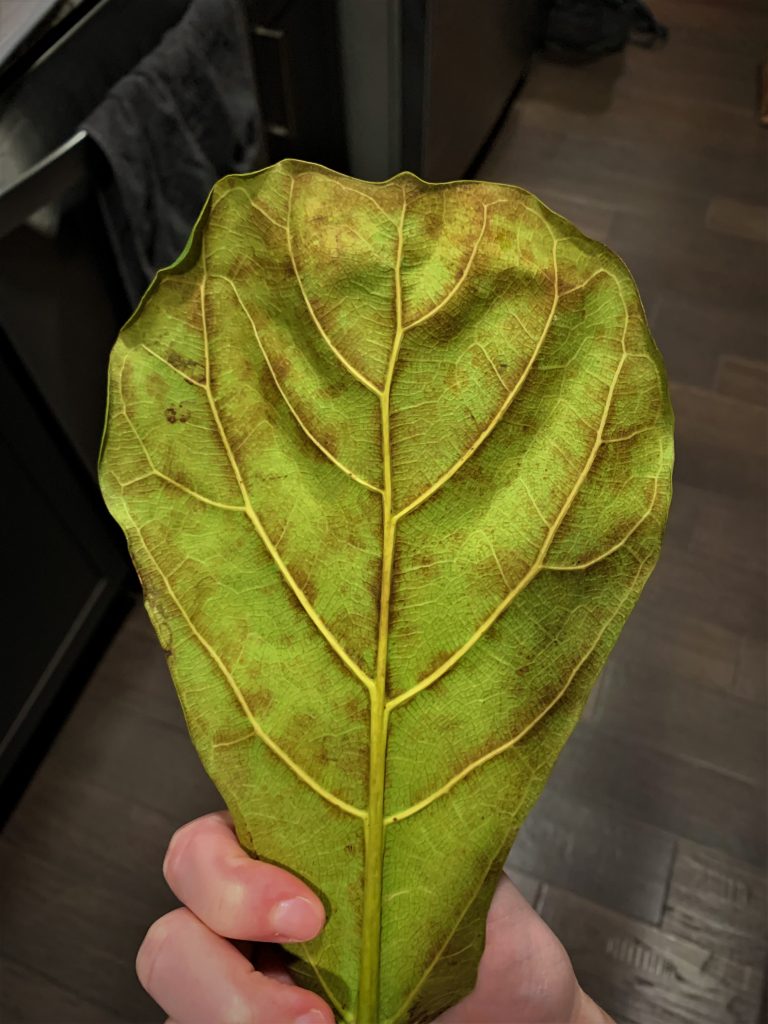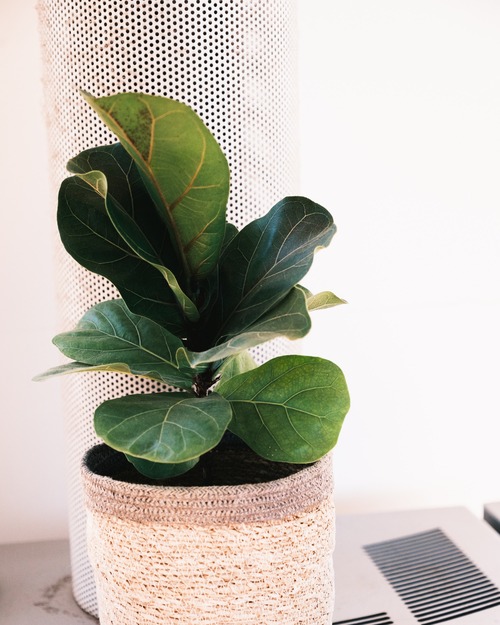Fiddle leaf figs are beloved indoor plants that thrive in full sun and require regular watering. They are known for their striking, glossy leaves that flourish in direct sun. However, fiddle leaf fig leaves can become sunburned when exposed to excessive sunlight. To prevent this, water your fig trees regularly. Understanding the signs and consequences of sunburn on trees, specifically your fiddle leaf fig tree, is crucial for its well-being. Sunburn can occur when the tree is exposed to excessive sunlight and lacks sufficient water.
Sunburn on fiddle leaf fig trees can manifest as brown or yellow spots on the leaves, accompanied by wilting or drooping foliage due to lack of water. If left untreated, a sunburned fiddle leaf fig can weaken the plant and lead to further damage. To prevent this, make sure to water your fig trees properly and address any issues with fiddle leaf fig troubleshooting. By learning how to recognize and address water and sunburn issues promptly, you can ensure the continued health and vitality of your fiddle leaf fig tree.

Signs of a Sunburned Fiddle Leaf Fig
Identifying Sunburn on Fig Trees
It’s essential to keep an eye out for signs of sunburned fiddle leaf fig trees. Make sure to water your fig trees regularly. Sunburned fig tree leaves may develop brown spots or patches, which can be a clear indication that your fig tree is getting too much direct sunlight. These brown spots can appear anywhere on the leaves of sunburned fiddle leaf fig trees and are usually irregular in shape.
In addition to brown spots, sunburned fig tree leaves may also become crispy or wilted. This happens because excessive exposure to sunlight can cause the water within the leaves of a sunburned fiddle leaf fig to evaporate rapidly, leading to dehydration and wilting. So if you notice that your fiddle leaf fig’s leaves are looking dry and brittle, it could be a sign of sunburn.
Another telltale sign of fiddle leaf fig sunburn is when the edges of the leaves turn yellow or brown. This discoloration occurs because the outer edges of the leaves receive more direct sunlight than the rest of the leaf surface. The intense heat from prolonged exposure to the sun can cause these edges to burn and change color.
Moreover, overexposure to sunlight can lead to bleached areas on the leaves. If your fiddle leaf fig is receiving too much sun, you might notice patches where the green color fades away, leaving behind a pale or yellowish hue. This bleaching effect occurs due to excessive sun breaking down chlorophyll pigments in the leaves.

Fiddle Leaf Fig Troubleshooting: Signs Your Ficus Lyrata Houseplant, also known as the fiddle leaf fig, is Getting Too Much Light in Full Sun.
To ensure your fiddle leaf fig thrives, it’s crucial to understand how much sun is just right for this tropical plant. If you notice that your fiddle leaf fig’s leaves are turning pale green or yellowish, it could indicate excessive exposure to the sun. In such cases, consider moving your plant away from direct sunlight or providing some shade using curtains or blinds.
Another sign that your fiddle leaf fig is receiving excessive sun is when its growth slows down or stops altogether. If you’ve been faithfully watering and fertilizing your plant, but it doesn’t seem to be growing as vigorously as before, it might be a sign that the intense sunlight is hindering its growth. Try relocating your fiddle leaf fig to a spot with less direct sunlight.
Drooping or curling leaves can also be an indication of too much direct sunlight. When a fiddle leaf fig receives excessive light, it tries to protect itself by curling or drooping its leaves to reduce surface area exposed to the sun’s rays. If you notice this behavior in your plant, consider moving it to a spot where it can receive bright indirect sun light instead.
Lastly, keep an eye out for burnt or scorched spots on the leaves caused by the sun. These sun spots usually appear as brown patches with dry and crispy edges. They occur when the intensity of the sunlight is too high for the fiddle leaf fig to handle. If you see these burnt spots on your plant’s leaves, take immediate action by adjusting its lighting conditions to ensure it receives enough sun.
Remember, finding the right balance of sun for your fiddle leaf fig is crucial for its overall health and well-being. By paying attention to these signs of sunburn and making necessary adjustments, you can ensure that your beloved indoor tree thrives in just the right amount of light.
Preventing and Treating Sunburn in Fiddle Leaf Figs
Should I Cut Off Burnt Fiddle Leaf Fig Leaves?
It is generally recommended to leave sunflowers intact unless they are completely dead and dry from being exposed to the sun. While the damaged leaves may not look aesthetically pleasing, cutting them off prematurely can hinder the plant’s recovery process from sun damage. However, if the leaves are only partially damaged by the sun, pruning them can help redirect energy towards new growth. It’s important to use clean tools when pruning to prevent further damage or infection. In some cases, removing severely burned leaves might be necessary if they pose a risk to the overall health of the plant.
Steps to Rehab a Fiddle Leaf Fig from Sunburn
If your fiddle leaf fig has suffered from sunburn, there are steps you can take to help it recover:
- Move your fiddle leaf fig away from direct sunlight into a shadier spot. This will protect it from further sun exposure and give it a chance to heal.
- Increase humidity around the plant by misting its foliage regularly. Sunburned leaves often become dry and brittle, so providing extra moisture can aid in their recovery.
- Water your fiddle leaf fig thoroughly but avoid overwatering during its recovery period. It’s crucial to strike a balance between keeping the soil moist without allowing it to become waterlogged.
- Apply a gentle fertilizer specifically formulated for houseplants. This will provide essential nutrients that promote new growth and support overall plant health.

Acclimatize Your Fiddle Leaf Fig to Prevent Sunburn
To prevent sunburn in the first place, acclimatizing your fiddle leaf fig is key:
- Gradually introduce your fiddle leaf fig to brighter light conditions over time. Start by placing the plant in a spot with indirect sunlight and gradually increase exposure as it adapts.
- Monitor the plant’s response and adjust its location accordingly. If you notice signs of stress or burning, move it to a slightly shadier spot until it acclimatizes further.
- Avoid sudden changes in light intensity, as they can lead to sunburn. Gradual adjustments allow the plant to develop stronger leaves that are more resistant to excessive sunlight.
Remember, prevention is always better than treatment. By taking the necessary precautions and gradually exposing your plant to brighter light, you can minimize the risk of sunburn and ensure its long-term health.
Consequences of Sunburn on Fig Trees
Severe sunburn can have detrimental effects on fiddle leaf figs, potentially causing permanent damage or even death to these beloved plants. When a fiddle leaf fig is exposed to intense sunlight for prolonged periods without proper protection, it can suffer from sunburn, which weakens its ability to carry out photosynthesis and hinders its overall growth.
Repeated episodes of sunburn can be particularly harmful to fiddle leaf figs. Each instance weakens the plant’s immune system and leaves it more vulnerable to diseases and pests. The growth of the tree may become stunted, resulting in smaller leaves and an overall weakened appearance.
One significant consequence of prolonged exposure to intense sunlight is irreversible leaf discoloration. Sunburned leaves often develop brown spots or patches that cannot be reversed or repaired. This not only affects the aesthetic appeal of the plant but also compromises its ability to absorb sunlight efficiently.
To better understand the consequences of sunburn on fiddle leaf figs, let’s delve into each talking point in more detail:

Severe sunburn can cause permanent damage or death to fiddle leaf ficus lyrata houseplants in shade.
When a fiddle leaf fig experiences severe sunburn, it can lead to irreversible damage that may eventually result in the death of the plant. The intense heat from direct sunlight causes cell damage within the leaves, disrupting their normal functions and inhibiting their ability to sustain life.
Sunburn weakens the plant’s ability to photosynthesize, hindering growth.
Photosynthesis is vital for a fiddle leaf fig’s growth and survival as it allows the plant to convert sunlight into energy. However, when a tree suffers from sunburn, this process is disrupted. The damaged cells are unable to efficiently carry out photosynthesis, leading to reduced energy production and hindered growth.
Repeated sunburn episodes can lead to a weakened immune system and stunted growth in the sunburned fiddle leaf fig.
Each time a fiddle leaf fig experiences sunburn, its growth potential becomes increasingly compromised. The repeated damage weakens the plant’s immune system, making it more susceptible to diseases and pests. As a result, the tree may struggle to thrive and exhibit signs of stunted growth.
Prolonged exposure to intense sunlight can result in irreversible leaf discoloration, especially in fig leaves. This can be exacerbated if the soil is not properly watered, leading to root rot.
One of the most visible consequences of sunburn on fiddle leaf figs is leaf discoloration. Sunburned leaves often develop brown spots or patches that cannot be reversed or repaired. This discoloration not only affects the overall appearance of the plant but also interferes with its ability to absorb sunlight effectively for photosynthesis.
Conclusion
In conclusion, it is crucial to be aware of the signs of sunburn in your fiddle leaf fig trees and take preventive measures to protect them. Signs of sunburn include brown spots or patches on the leaves, wilting, and overall decline in health. To prevent sunburn, ensure that your fiddle leaf figs are placed in a location with bright, indirect sunlight and avoid exposing them to intense midday sun. If you notice any signs of sunburn, promptly move your plant to a shadier spot and gently clean the affected leaves with a damp cloth.
Sunburn can have severe consequences for fiddle leaf fig trees if left untreated. It can weaken the plant’s immune system, making it more susceptible to pests and diseases. Prolonged exposure to direct sunlight can lead to permanent damage and even death of the tree. Therefore, it is essential to provide proper care and attention to your fiddle leaf figs by monitoring their light exposure regularly.
To ensure the health and longevity of your fiddle leaf fig trees, consider implementing these preventive measures: finding an ideal spot with adequate indirect sunlight, rotating the plant periodically for even growth, using curtains or blinds to filter harsh sunlight during peak hours, and providing regular misting or humidity trays for added moisture. By following these guidelines and being attentive to signs of sunburn, you can help your fiddle leaf figs thrive in their environment.
If you have any further questions or need assistance regarding caring for your fiddle leaf figs or any other houseplants, feel free to consult a local horticulturist or reach out to online gardening communities where experienced enthusiasts can offer valuable advice tailored specifically for your plant’s needs. Remember that proper care is crucial for maintaining healthy plants that will bring beauty into your living space for years to come!
FAQs
Can fiddle leaf fig plants get sunburned?
Yes, fiddle leaf fig plants can indeed get sunburned. These tropical beauties love bright, indirect light, but direct sunlight can scorch their delicate leaves.
How do I know if my fiddle leaf fig trees has sunburn risk from bright light during the day?
If your fiddle leaf fig has brown or yellow patches on its leaves, it may be suffering from sunburn. The affected areas may appear dry and crispy as well. Keep an eye out for these signs to catch the issue early.
What should I do if my fiddle leaf fig trees gets sunburned? Sunburn can be a risk for trees, including fiddle leaf figs. To help the tree recover, it is important to provide adequate water and ensure the soil is healthy and well-drained.
If your fiddle leaf fig shows signs of sunburn, immediately move it to a spot with less direct sunlight. Find a location where it can still receive bright, indirect light without being exposed to harsh rays.
Can I save my sunburned fiddle leaf fig?
In most cases, you can save your sunburned fiddle leaf fig with proper care and attention. Trim off any severely damaged leaves and provide the plant with adequate shade. Ensure you’re following proper watering and fertilizing practices to help it recover.
How can I prevent my fiddle leaf fig trees from getting sunburned? Fiddle leaf fig trees need water, soil, and proper sunlight to thrive.
To prevent your fiddle leaf fig from getting sunburned in the future, place it in a spot that receives bright, indirect light. Avoid placing it near windows with intense afternoon sunlight or directly under artificial lights that emit excessive heat.
Remember, always monitor your plant’s condition and adjust its positioning accordingly to maintain its health and beauty!
